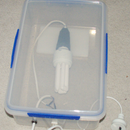Introduction: Measuring Area of Irregular Shapes
This instructable combines a few mathematical tricks to enable you to calculate the area of irregular shapes.
I come from a farming background. One of the things we often had to do, was measure the area of a section of land in order to calculate how much fertiliser was required.
This can be done from maps, (E.g. using Google Maps measure tools) but this doesn't take into account variations in height. Our farm was in a moderately hilly area, and often the real area of a paddock was 20% more than what the maps said.
This instructable could also be used to measure area of irregular plane shapes, as well as surface area of 3D shapes.
Step 1: Heron's Formula - Calculating the Area of a Single Triangle.
Heron's formula is a way to calculate the area of ANY triangle, knowing the lengths of it's three sides, a, b and c. More information can be found at http://en.wikipedia.org/wiki/Heron%27s_formula
Firstly, calculate the semiperimeter. This is just half of the triangle's perimeter.
s = (a + b + c) / 2
In our example,
s = (6.56 + 6.01 + 5.76)/2
s = 9.165
-----------------------------------------------------------------
Then, calculate the following differences:
s - a
s - b
s - c
E.g.
s - a = 9.165 - 6.56 = 2.605
s - b = 9.165 - 6.01 = 3.155
s - c = 9.165 - 5.76 = 3.405
------------------------------------------------------------------
Finally, substitute your answers into the following equation:
A = sqrt( s * (s-a) * (s-b) * (s-c) )
(Multiply the three differences together, along with the semiperimeter, and then take the square root.)
A = sqrt( 9.165 * 2.605 * 3.155 * 3.405)
A = sqrt( 256.482)
A = 16.015
This gives the area of a single triangle.
Step 2: Triangulating a Complex Shape
To use Heron's formula on a complex shape, all we have to do is split the shape up into a series of triangles, and measure all the edges.
This can be done using Delaunay Triangulation for highest efficiency, but any set of triangles will work. http://en.wikipedia.org/wiki/Delaunay_triangulation
Basically, quadrilaterals are split along their shortest diagonals. This will ensure that your triangles aren't thin and narrow.
Once you have your shape split into triangles and all the edges are measured, calculate Heron's Formula for each triangle, and then add the areas together for a total.
Step 3: Using a Spreadsheet to Make Life Easier.
Rather than calculate each triangle by hand, you can save yourself some effort by using a spreadsheet. I have attached an example in OpenOffice and Excel formats.
All you have to do is add in values of a,b and c for each triangle, and it will calculate areas and give you a total.
Edit:
I have included versions of the spreadsheet, that have all but the a,b and c cells protected. There is no password, and it's up to individuals if they want the normal or the protected versions. :)
To make it a little more clear, the protected versions just prevent you from accidentally erasing or changing the formulas, but they only go up to 30 triangles.
The normal versions should allow people to adjust the spreadsheet if they want to.
You can thank sonogo for this excellent suggestion.
Step 4: Getting Measurements
To get measurements over moderate to large distances, you can use string-lines or measuring (surveyor's) wheels. (I'm a bit surprised I can't find an instructable for how to make one.)
Alternatively, with a bit of practice with a measuring tape, you can learn how to stride regular 1m (*sigh* or for the irredeemably Imperialist, 1 yard) steps, and pace out rough distances.
The advantages of this method are that:
- there is nothing saying that the triangles have to all lie in the same plane. As long as each triangle section is moderately flat, this method will work with any 3D surface.
- you only need to measure distances. No angles are required. Methods requiring angles can be sensitive to errors of 1/2 a degree over large area. This gives good approximations even if your distances are out by 1 to 2 metres.
If you wanted to measure the surface area of a small 3D shape, you could use string lines to draw triangles over it's surface, and then measure the length of each edge.














